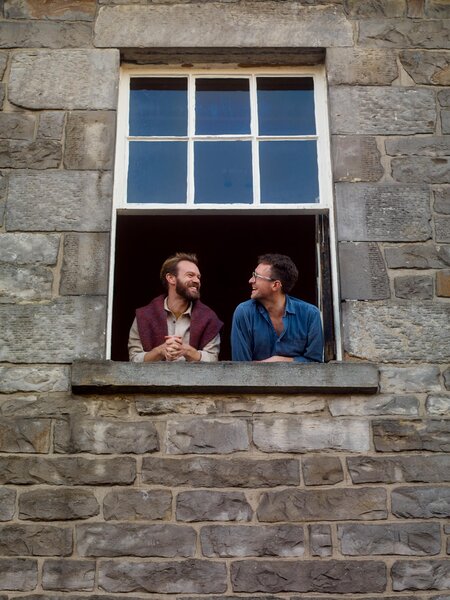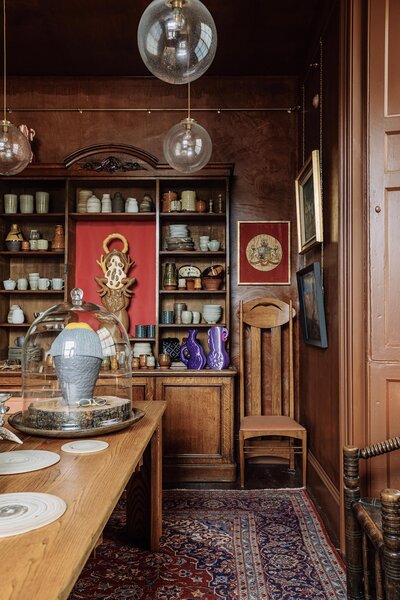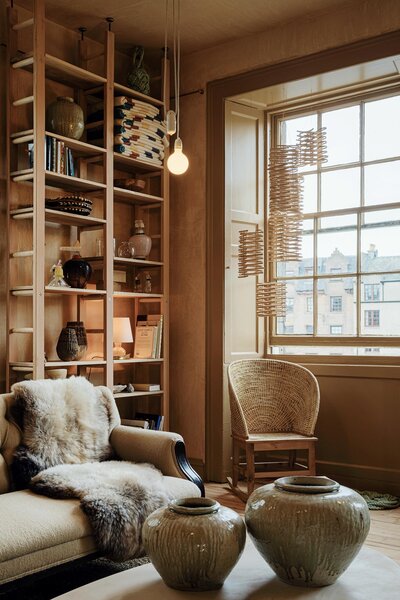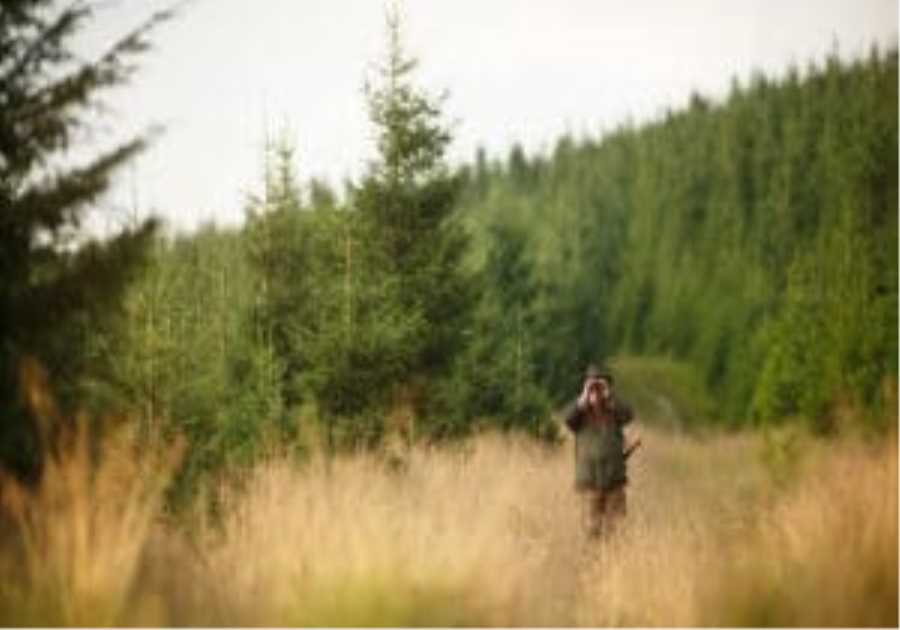Bard, which is now open to shop in person and online, hopes to highlight "the finest, most interesting ideas, objects, and stories from all over Scotland."
It’s a dreary, overcast day in Edinburgh, the streets slick from recent rainfall, but I’ve arrived at the hip waterfront district of Leith for a cheerful occasion. Along with a small crew of other design aficionados, I’m one of the first people to cross the threshold at Bard, a new shop and gallery showcasing Scottish craft and design that opened to the public November 10.
The paint has barely dried, so to speak. Bard’s founders, husbands Hugo Macdonald and James Stevens, welcome us in with jovial smiles, looking appropriately cozy in their chunky sweaters. Macdonald is a design writer and curator whose resume includes stints at Wallpaper, Monocle, and the studio of British designer Ilse Crawford; Stevens is an architect who’s had Eddie Redmayne and Helena-Bonham Carter among his clients. From July to September this year, the pair scoured the country for makers to showcase at Bard. They originally intended to meet with 25 creatives but ended up connecting with exponentially more through Scotland’s tight-knit craft community. "We were keen to see as many people as we could and not judge makers or their work in advance solely on their online presence," says Macdonald. "It can be a misleading window through which to understand reality."

Husbands Hugo Macdonald and James Stevens founded Bard in the waterfront Leith district of Edinburgh, Scotland.
Photo by Norman Wilcox-Geissen
"We met everyone, we stood in everyone’s studio, we smelled what they smelled like," adds Stevens, laughing: "We know what their dog’s like, we’ve drank their tea. Those are the things that are embedded in our knowledge of these objects."
Genuine connection and salt-of-the-earth hospitality feel tangible on the ground floor of the Bard, which overlooks the Water of Leith, a river that flows through the port district. Candles flicker in antler candelabras by Scottish Highlands horn carver Mclean of Braemar, illuminating an oversize wooden table laden with glassware and the earthy tactility of burnt-sienna plaster walls. A Victorian oak bookcase, flanked by oil paintings, displays some of the store’s folksy ceramics selection. The couple’s inspiration for this space, they tell me, was "baronial punk"—as though a young collector inherited a property from their grandparents and gave it an avant-garde update. The homey feel is designed to put visitors at ease, and the objects in conversation with each other. "There was always a missing link [for] a space that could present craft in an accessible way that wasn’t objects on plinths, but wasn’t a gift shop, either," says Macdonald.
Bard—named for the Celtic word for "storyteller"—occupies Scotland’s oldest custom house, built in 1812 to collect customs duty on incoming shipments. "We loved the fact that this port is where Edinburgh met the world, and where the world met Edinburgh," says Macdonald. "We like to think we will continue that tradition by showcasing the finest, most interesting ideas, objects, and stories from all over Scotland."

The new shop and gallery showcases works by contemporary makers and designers in Scotland across two floors.
Photo by Edvinas Bruzas
Macdonald, who grew up on the rugged Isle of Skye, has always felt the gravity of his heritage. He’s in line to succeed his father as the 38th chief of the Macdonald clan, one of the largest and oldest Scottish clans (ancient kinship groups divided by region). "It simultaneously means everything and nothing because it’s entirely ceremonial," Macdonald says. "Today, clans have no power whatsoever, but for the Scottish diaspora around the world, they’re like a lodestone for personal and cultural identity."
The couple’s journey to opening Bard has been, like any worth talking about, full of twists and turns. Ten years ago, Macdonald and Stevens (originally from Dorchester, England) met in London, where they lived before moving to the seaside town of Hastings in 2015. That same year, on a trip to Edinburgh, they were surprised by the lack of storefronts that celebrated both contemporary and traditional Scottish craft. As the pandemic spurred lockdown after lockdown, the two decided that perhaps they would be the ones to create such a space. They returned to Edinburgh this past Easter, intending to settle in for a few years before setting up shop.
"We were sitting on the other side of the wharf over there looking at this building and thinking, ‘It would be amazing if we could get a building like that to put Bard in,’" says Macdonald. At the time, the storefront was occupied by Scottish menswear brand Kestin, and was all exposed cables and raw walls. ("It was derelict," says Stevens. "It felt very Berlin.") As luck would have it, the designer left the building for larger pastures the very next week. The couple leapt at the opportunity, getting the keys in August, but the lease meant they had to shorten the runway for opening—from three years to just three months.
"There are lots of visions of Scotland that are very earnest and beautiful but don’t entirely capture it. Another important aspect of Scottishness that we were keen to explore was playful cheekiness."
The pair usher our chattering group upstairs to continue the tour. Hanging in the stairwell is an arresting tapestry made out of knotted teal rope—what the founders call "ghost rope," once used on fishing boats and discarded. Some 11,000 tons of it end up in the seas of Europe each year. Mark Cook, an artist originally from Birmingham, England, and now living on the Scottish archipelago of Orkney, gathers detritus from the beach and accepts donations from local fishermen to create upcycled doormats and pineapple-shaped door stops, both of which are featured at Bard.
The tapestry, which the couple found hanging outside Cook’s garage when they visited, was the artist’s lockdown experiment. "We thought it was the most interesting piece of contemporary folk art in a very Scottish tradition: weaving found material into something incredibly intricate that gives it an elevated second life," says Macdonald. "We begged him to be able to hang it in Edinburgh as a piece of art. At that point, we didn’t know if we had the space for it. You should have seen us trying to hang it up."

Stevens designed the ladder shelving system in the upstairs showroom.
Photo by Edvinas Bruzas
See the full story on Dwell.com: Talking Shop With the Duo Behind Scotland’s Newest Craft Showcase
Related stories:
- How E-Commerce Changed the Knock-Off Furniture Game
- They Built ‘The Woks of Life’ From Home. Now They’re Cooking Things Up From a New One
- How "The White Lotus" Found Frisky Inspiration in a Real-Life Sicilian Villa
Read More
By: Jenny Xie
Title: Talking Shop With the Duo Behind Scotland’s Newest Craft Showcase
Sourced From: www.dwell.com/article/talking-shop-with-the-duo-behind-bard-scotlands-newest-craft-showcase-36b8956e
Published Date: Mon, 21 Nov 2022 20:11:25 GMT
.png)





